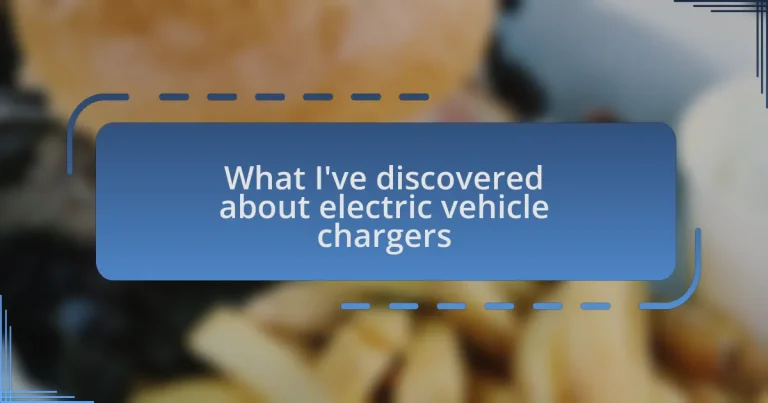Key takeaways:
- Electric vehicle (EV) chargers are essential for sustainable transportation and enhance the overall EV experience.
- There are three main types of chargers: Level 1 (slow, basic), Level 2 (faster, more convenient), and DC fast chargers (quickest for long journeys).
- The expansion of the charging network is crucial in alleviating range anxiety and encouraging more people to switch to electric vehicles.
- Charging stations often create opportunities for eco-friendly practices and transform travel into enjoyable adventures.
Author: Olivia Hartwell
Bio: Olivia Hartwell is a contemporary fiction author known for her compelling narratives and vivid characterizations. With a background in literature and creative writing, she has a keen eye for detail and a passion for exploring the complexities of human relationships. Olivia’s debut novel, Whispers of the Heart, received critical acclaim and was nominated for several literary awards. When she’s not writing, she enjoys hiking in the mountains of Colorado and sipping artisanal coffee at local cafes. Olivia resides in Denver with her beloved rescue dog, Rosie.
Understanding electric vehicle chargers
Electric vehicle chargers come in a few different types, and understanding these can really change your EV experience. For instance, I remember visiting a bustling café where they had a Level 2 charger; I could sip on my coffee while my car charged more quickly than I expected. Isn’t it fascinating how our daily routines can blend with technology in such a seamless way?
Then there are DC fast chargers, which can completely rejuvenate an electric vehicle in a matter of minutes. I once found myself at a roadside stop with a DC charger, feeling a mix of impatience and excitement as I watched the battery percentage rise rapidly. Have you ever felt that surge of anticipation waiting for your device to charge? It’s similar—a quick boost can transform your journey.
The charging network is expanding, which means that range anxiety is slowly fading away. I often share stories with fellow EV enthusiasts about the new spots we’ve discovered lately, and it’s incredible how a well-placed charger can turn an ordinary trip into a delightful adventure. Don’t you think that as we embrace this technology, it creates opportunities for us to explore new places?
Importance of electric vehicle chargers
Electric vehicle chargers are more than just fuel for your car; they are vital to the growth of sustainable transportation. I remember a time when I stopped by a farmer’s market that boasted a few EV chargers, allowing me to shop leisurely while my vehicle powered up. Isn’t it wonderful how these charging stations can encourage eco-friendly practices and make green living more accessible?
Considering the rise of electric vehicles, having a robust charging infrastructure is crucial. I once encountered a situation where I had to adjust my route because my favorite park didn’t have a charger nearby. The frustration I felt was a stark reminder of how important it is for these chargers to be widespread and convenient. How can we expect more people to make the switch to electric if charging isn’t just around the corner?
Moreover, reliable access to chargers enhances the overall EV experience. I often tell friends about my road trip to the coast, where strategic charger placements allowed me to relax and enjoy the scenery rather than fret about finding a station. Can you imagine how liberating it feels to travel without worrying about your car’s charge? The importance of electric vehicle chargers cannot be overstated—they unlock the potential for stress-free, eco-conscious journeys.
Types of electric vehicle chargers
When it comes to electric vehicle chargers, there are several types that cater to different needs. Level 1 chargers are the most basic, typically using a standard household outlet. I recall using one at a friend’s house during a weekend getaway; I plugged in overnight and had enough charge for my driving the next day. This option is perfect for someone who drives short distances daily but lacks immediate access to faster solutions.
On the other hand, Level 2 chargers are a significant step up, offering a faster charge that can replenish an EV in just a few hours. I remember being pleasantly surprised when I found a Level 2 station at a nearby shopping mall. I was able to plug in while running errands, and within an hour, I had more than enough charge to get home. Isn’t it exciting how convenient these chargers make life?
Lastly, there are DC fast chargers, which are ideal for long journeys as they can significantly reduce charging time, providing an 80% charge in about 30 minutes. I once took a road trip where my wife and I made a pit stop at a fast charger. By the time we enjoyed a quick bite, our car was ready, and we were back on the road without missing a beat. These chargers really change the game for anyone looking to explore farther without the anxiety of charging stops.


